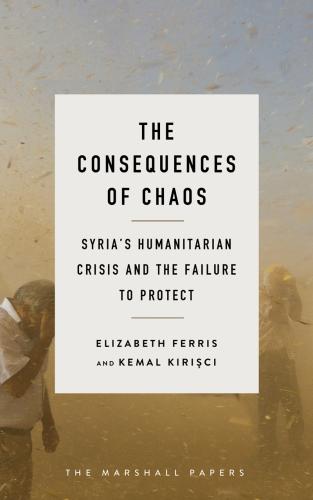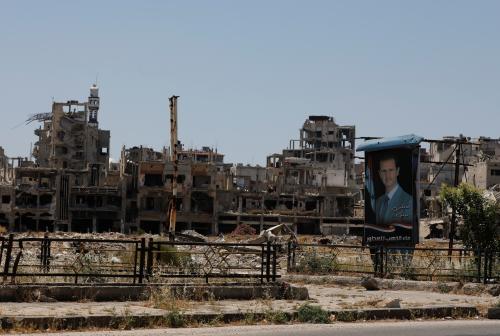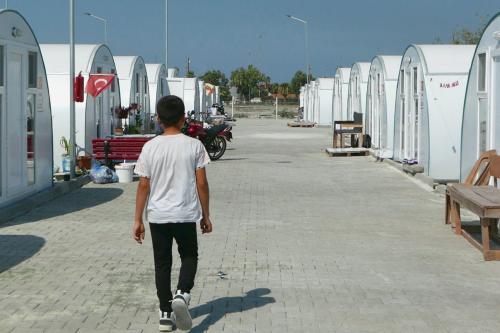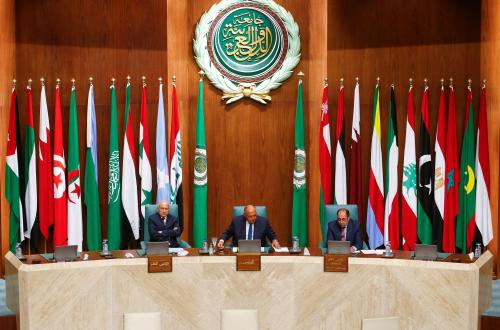This piece is part of a series titled “Nonstate armed actors and illicit economies in 2022” from Brookings’s Initiative on Nonstate Armed Actors.
In late January, Islamic State group (IS) fighters launched an audacious attack on al-Sinaa prison just outside Hasaka in northeast Syria. Hundreds of the IS attackers were killed before the Kurdish-led Syrian Democratic Forces (SDF), backed by the U.S. military, regained control of the facility. However, hundreds more — including large numbers of IS prisoners — are believed to have escaped into the desolate borderlands between Syria and Iraq. Days later, U.S. President Joe Biden announced that U.S. forces had succeeded in killing IS leader Abu Ibrahim al-Hashimi al-Qurayshi in his safe-house outside the town of Atmeh, 250 miles west of Hasaka along the Syrian-Turkish border.
Media coverage and the quick-take analysis that inevitably follows such events struggled to present a coherent narrative. Did the brazen prison attack signal the resurgence of IS? Was al-Qurayshi’s death a major blow to a group weakened by losses, the latest in a string of defeats that have weakened the leadership of a fractured if still deadly extremist network? Or would IS morph, regroup, and continue its ruthless campaign to regain control over territories it lost with the final defeat of its caliphate in 2019?
The answer to these questions may well be all of the above. Yet in focusing on what these two events tell us about IS, we should also ask what they tell us about U.S. policy in Syria and whether it is working. Since at least 2015, the U.S. has distanced itself from what might be called a comprehensive or dual-track strategy in Syria — a policy that included military pressure on the Assad regime, alongside vigorous counterterrorism efforts. Instead, it shifted to a single-track counterterrorism strategy, withdrawing its military support for the regime’s opponents and narrowing its role to focus on the battle against the Islamic State group.
This shift in Syria is a signature component of the broader recalibration of U.S. foreign policy away from failed efforts at nation building and toward limited, more sharply defined objectives that the administration presents as more achievable and realistic. In an interview in January, Brett McGurk, Middle East coordinator in the National Security Council, stressed this change. In the past, he said, the U.S. had pursued maximalist objectives in the Middle East that were unattainable, from regional transformation to democratization to regime change. Under the Biden administration, the U.S. would “align ends and means,” limiting its horizons to the immediate challenges it inherited from its predecessors, including the ongoing counterterrorism work carried out by the Global Coalition to Defeat ISIS.
Enveloped in the vernacular of reasonableness, realism, and the pursuit of the achievable, there is much in the administration’s approach to admire. McGurk is not wrong to point to the dangers of overpromising and underperforming; the costs of American hubris have been high both at home and, to an even greater extent, abroad. Yet the breach of al-Sinaa prison and the death of al-Qurayshi are troubling indicators that Washington has over-calibrated in narrowing its objectives in Syria to support for counterterrorism operations.
There is little doubt about the lethality of U.S. forces in Syria or their capacity to succeed in high-risk operations like the strike against al-Qurayshi. Whether these capabilities are sufficient to achieve a decisive victory over IS, much less stabilize eastern Syria and create the conditions in which U.S. forces will no longer be needed, is another matter entirely. To do so it will be necessary for the U.S. to look beyond simply degrading IS’s military capabilities and engage more directly in addressing the sources of IS resilience. These include but go well beyond the conditions that permitted IS to reconfigure itself after 2019 as a decentralized, dispersed, and non-hierarchical network, able to exploit what researchers refer to as areas of limited statehood and sustain its campaign to reestablish its authority.
Eastern Syria presents an environment that is particularly well-suited to a flexible, adaptive nonstate actor like IS. It is an intensely contested political space in which multiple state and nonstate actors compete for influence, where regional and local rivalries and antagonisms fuel cross-cutting tribal, ethnic, sectarian, and generational cleavages that such actors can exploit, and where longstanding economic and social grievances are amplified by uneven and inadequate efforts to respond to the trauma and destruction that IS rule and a decade of civil conflict have created.
In the midst of this political maelstrom, the U.S. has aligned itself with one nonstate actor, the SDF. This alliance of forces is controlled by the Kurdish People’s Protection Units (YPG), with Kurdish fighters constituting a majority of its members. Choosing to work “by, with, and through” the SDF makes sense from a counterterrorism perspective. Kurdish forces have been highly effective in the battle against IS. The SDF is a problematic choice however, when it comes to other aspects of the larger struggle to defeat IS.
Under U.S. auspices, the SDF has become the de facto governing authority, the “key powerbroker,” over Arab majority areas that largely reject its legitimacy and view its governance as arbitrary, abusive, and discriminatory. It is seen by Turkey as an armed wing of the Kurdistan Workers’ Party (PKK), a designated terrorist organization, and is routinely targeted by Turkish forces and their Syrian nonstate affiliates who operate in Turkish-occupied areas of northern Syria. In outsourcing local governance to the SDF, the U.S. is contributing to conditions in which local grievances thrive. It has fostered an environment of resentment in which IS, along with many other actors including Turkey, the Assad regime, Russia, and Iran, can actively compete to cultivate disgruntled local allies and expand their influence within Arab communities. Dense tribal networks that stretch across eastern Syria and beyond have been a particular target of such efforts, including by IS which exploits discontent among Arabs to entice new recruits into its ranks.
A severe lack of resources to support local alternatives to IS further hampers efforts to weaken its appeal. U.S. funding for local stabilization efforts, cut off under the Trump administration, was renewed under Biden but remains woefully inadequate. Civilian assistance programs intended to strengthen alternatives to the SDF in Arab communities, incorporate tribal leaders, and improve local governance have struggled to compete not only against IS, but against the more robust efforts of the Assad regime, Iran, and Russia.
In addition, to avoid the impression of overreach or the charge that the U.S. is again embarked on a nation-building project, stabilization programming has been streamlined. It addresses a limited range of immediate needs, rather than the longer-term challenges of social repair, governance, and political inclusion that should not be managed by the SDF.
What U.S. policy has produced, therefore, is an environment in which the long-term effectiveness of its limited counterterrorism goals is undermined by the limits of its short-term focus on counterterrorism.
To overcome such limits, to recognize that it will not be possible to defeat IS without mitigating the conditions that nurture it, need not and should not draw the U.S. back into the flawed strategies that were tried and failed in Afghanistan and Iraq. In their place, the U.S. needs to buttress its counterterrorism strategy with a policy that aims to create “good enough governance” on the ground in eastern Syria and emphasizes “governance building” rather than state building, through efforts that empower actors who are truly locally legitimate.
This shift to a governance-focused, “root causes” strategy in Syria would be consistent with how the Biden administration has approached other foreign policy challenges. In June 2021, it released a “root causes strategy” to respond to the migration crisis on the southern border. According to the White House, the strategy “identifies, prioritizes, and coordinates actions to improve security, governance, human rights, and economic conditions” in Central America. A similar approach, tailored to reflect the complex terrain of eastern Syria, would offer a useful starting point for moving beyond a counterterrorism policy that, on its own, is unlikely to achieve the enduring defeat of the Islamic State group.








Commentary
Not by counterterrorism alone: Root causes and the defeat of the Islamic State group
February 17, 2022